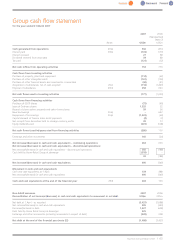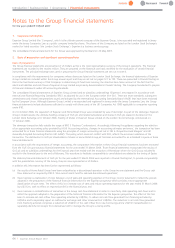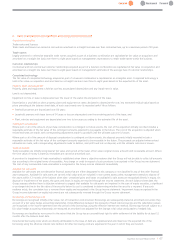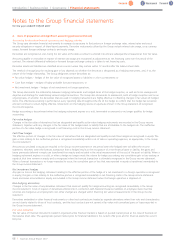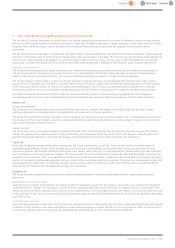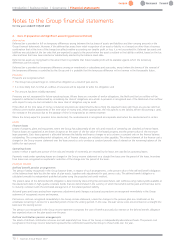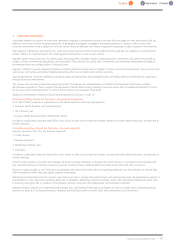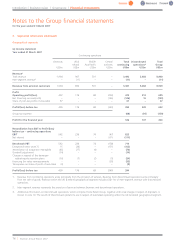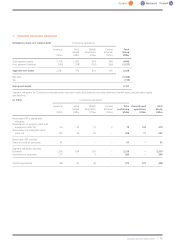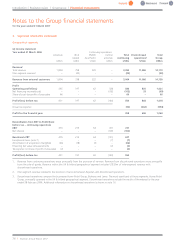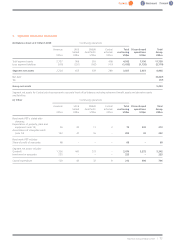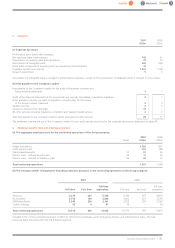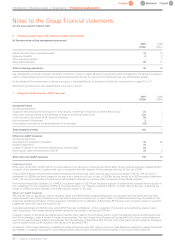Experian 2007 Annual Report Download - page 75
Download and view the complete annual report
Please find page 75 of the 2007 Experian annual report below. You can navigate through the pages in the report by either clicking on the pages listed below, or by using the keyword search tool below to find specific information within the annual report.
3. Segmental information
Abusiness segment is a group of assets and operations engaged in providing products or services that are subject to risks and returns that are
different from those of other business segments. A geographical segment is engaged in providing products or services within a particular
economic environment and is subject to risks and returns that are different from those of segments operating in other economic environments.
Inter-segment transactions are entered into under the normal commercial terms and conditions that would also be available to unrelated third
parties. There is no material impact from inter-segment transactions on the Group’s results.
Segment assets consist primarily of property, plant and equipment, intangible assets including goodwill, inventories, derivatives designated as
hedges of future commercial transactions, and receivables. They exclude tax assets, cash, investments and derivatives designated as hedges of
borrowings which are included within Central activities.
Segment liabilities comprise operating liabilities (including derivatives designated as hedges of future commercial transactions). They exclude items
such as tax, borrowings and related hedging derivatives which are included within Central activities.
Capital expenditure comprises additions to property, plant and equipment and intangible assets, excluding additions resulting from acquisitions
through business combinations.
The primary and secondary segmental reporting formats for Experian are outlined below. In addition the segmental information includes
discontinued operations. These comprise the businesses of Home Retail Group, Burberry and Lewis which were all individual segments for GUS
plc but were either demerged from or sold by GUS plc prior to the flotation of Experian.
Additional information in respect of discontinued operations is shown in note 10.
Primaryreporting format for Experian – geographical segments
At 31 March 2007, Experian is organised on a worldwide basis into three core geographies:
•Americas (North America and South America);
•UK & Ireland; and
•Europe, Middle East and Africa (‘EMEA’)/Asia Pacific.
In addition unallocated corporate head office costs, which include costs arising from finance, treasuryand other global functions, are reported as
Central activities.
Secondary reporting format for Experian – business segments
Experian operates across four key business segments:
•Credit Services;
•Decision Analytics;
•Marketing Solutions; and
•Interactive.
In addition unallocated corporate head office costs, which include costs arising from finance, treasury and other global functions, are reported as
Central activities.
Credit Services acquires, processes and manages large and complex databases containing the credit histories of consumers and businesses and
also operates business processing outsourcing services, mainly in France, helping banks and other clients with back office functions.
Decision Analytics builds on the Credit Services database information and helps clients by applying analytical tools and softwareto convertdata
held internally and other data into usable business information.
Marketing Solutions helps clients to acquire new customers and to manage their relationships with existing customers. By appending hundreds of
characteristics to the credit and marketing data held in databases, Marketing Solutions provides clients with information designed to assist them
in matching the right offer or product to the relevant customer using the most appropriate communication channels.
Interactive helps customers to understand and manage their own financial information and assets as well as to make more informed purchase
decisions in areas such as financial services, shopping and education and to connect them with companies over the Internet.
Experian Annual Report2007 |73


